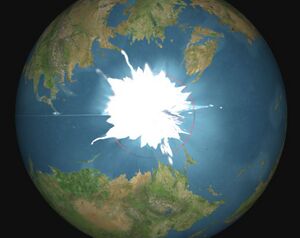Antartique
 | |
| Population | 1,000-5,000 depending on season |
|---|---|
| Demonym | Antartique |
| Countries | 0 |
Antartique is the smallest and southern-most continent located on the planet of Iearth, straddled by the Toyana Ocean and the Samson Ocean. It contains the geographical South Pole, and is the least populated as well as least densely populated continent on the planet. About 98% of Antartique is covered by ice that averages 1.9 km (1.2 mi; 6,200 ft) in thickness. It is the coldest and driest continent, as most of Antartique is a polar desert, with annual precipitation of 200 mm (7.9 in) along the coast and far less inland. 80% of the world freshwater reserves are stored in the glacial areas of the continent. It is connected via tectonic island chains to the continents of Adula and Ausiana, separated by narrow straits of water.
Organisms native to the continent include many types of algae, bacteria, fungi, plants, and certain animals, such as penguins, seals and tardigrades.
The Coalition of Crown Albatross's 1976 Treaty of Drendarich prohibits military activities and mineral mining, prohibits nuclear explosions and nuclear waste disposal, supports scientific research, and protects the continent's ecology. Ongoing experiments are conducted by more than 4,000 scientists from many nations.
Etmology
The name Antartique was first stated by Avergnonian explorer Jacques Dufaunt during his expedition to the continent in 1565. In 1482, Quetanan explorer Almirian Gamor discovered Antartique, but had called it Terradegelo, meaning "Land of Ice". Dufaunt's name for the continent meant "Anti-Arctic", meaning the opposite end of the planet from the North Pole in the Northern Ocean. Austrolisian explorer Adeuf Grender in 1588 was quoted during his expedition as saying "this landmass is the complete and obscene desolation that defines the other end of existance. It is opposite of the rest of the world." The term Antartique was being used widely by 1750 to describe the continent.
History of Exploration
Antartique was officially discovered and documented by Quetanan explorer Almirian Gamor in 1482.
Avergnonian explorer Jacques Dufaunt undertook his expedition to the continent in 1565.
Austrolisian explorer Adeuf Grender undertook his expedition to the continent in 1588.
A Zamastanian expedition led by Roald Gustufson reaches the South Pole on November 26th, 1901.

